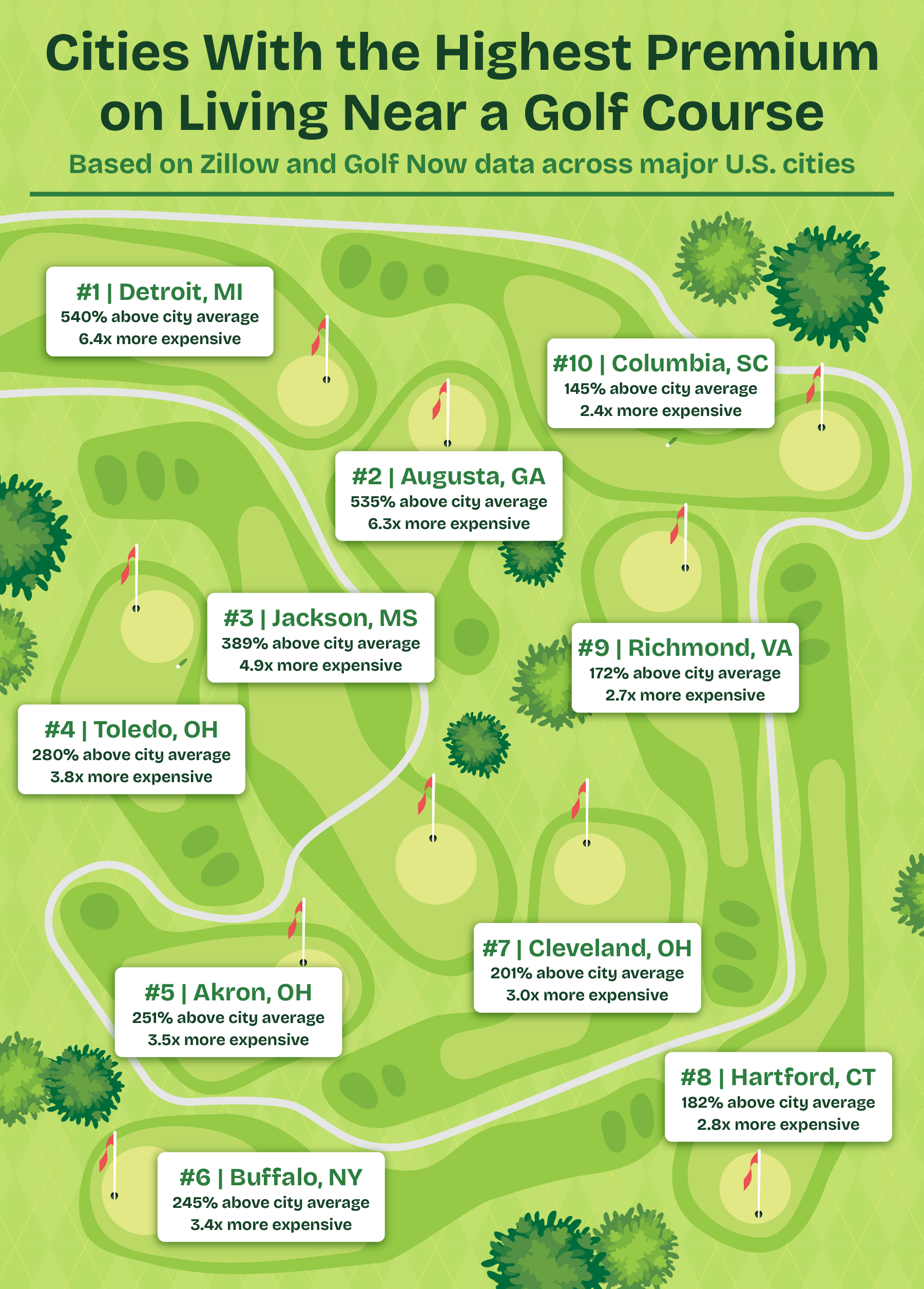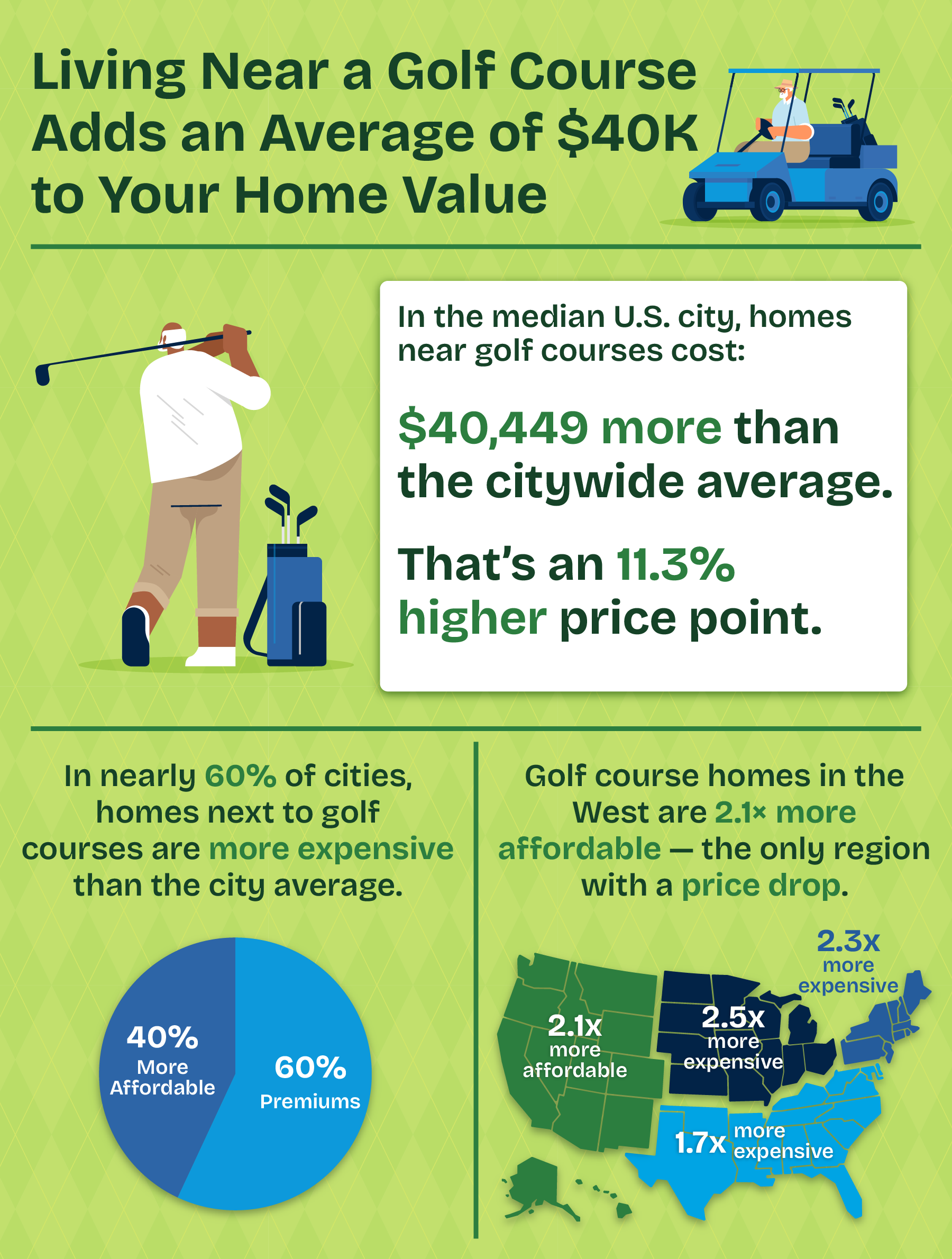
Living alongside a golf course might seem like a dream for many—tranquil views, access to the fairway, and a quiet neighborhood lifestyle. But what does that dream cost in today’s housing market?
To find out, we analyzed average home values across 70 major U.S. cities and compared them to those in ZIP codes that include at least one golf course, using listings from GolfNow and pricing data from Zillow. The results reveal which cities carry the steepest price tags for golf course living, and which ones offer a more affordable escape from the city center.
Read on to find out how your city stacks up—and whether golf course living comes with a luxury price tag or hidden savings.
A Comparison of Golf Course Living Costs by Region
In the median U.S. city, homes in ZIP codes with at least one golf course cost on average $40,449 more than the citywide average—a premium of 11.3%. Nearly 60% of cities showed elevated home values in these golf-centric neighborhoods, suggesting a consistent demand for the scenic, low-traffic lifestyle golf communities offer.
But when you zoom out to a regional view, the story becomes even more compelling. In the Midwest, homes in golf neighborhoods are, on average, 2.5 times more expensive than others in the region—a staggering 139.6% premium. The Northeast follows with homes 2.3 times more expensive, while the South posts a solid 1.7x premium over the regional average. Cities in these regions often feature courses with historical or recreational prestige, such as Shaker Heights Country Club in Cleveland or Bethpage State Park in Long Island, driving up demand and prices.
However, the West bucks the trend entirely. In this region, homes in golf course ZIP codes are actually 32.1% less expensive than the regional average—making them 2.1 times more affordable. In cities like San Francisco, Santa Rosa, and San Jose, living next to golf courses like TPC Harding Park or Santa Teresa Golf Club may offer a more budget-friendly alternative to the high-priced city core.
Cities Where It Costs More (and Less) to Live Near a Golf Course

While regional trends reveal broad patterns, the real differences emerge at the city level. In some metro areas, buying a home near a golf course comes with a staggering markup—while in others, it could actually save you money.
Cities With the Highest Premiums for Golf Course Living
At the top of the list is Detroit, MI (Rank #1), where homes in golf course ZIP codes—such as those near the historic Detroit Golf Club—cost a jaw-dropping 540% more than the city average. That’s 6.4 times the price of a typical Detroit home.
Augusta, GA (Rank #2), home to the world-famous Augusta National Golf Club, follows closely with a 535% premium—about 6.3 times the citywide average. In Jackson, MS (Rank #3), golf course living costs nearly five times more than elsewhere in the city.
Rounding out the top 10:
- Toledo, OH – 280% more expensive (3.8x city average)
- Akron, OH – 251% more expensive (3.5x city average)
- Buffalo, NY – 245% more expensive (3.4x city average)
- Cleveland, OH – 201% more expensive (3.0x city average)
- Hartford, CT – 182% more expensive (2.8x city average)
- Richmond, VA – 172% more expensive (2.7x city average)
- Columbia, SC – 145% more expensive (2.4x city average)
These dramatic increases indicate strong demand for golf-centered communities in cities where traditional housing remains more affordable. In these locations, proximity to scenic fairways and private greens drives a significant home value premium.
Cities Where Golf Course Living Is More Affordable
In contrast, some of the country’s priciest housing markets offer welcome relief in golf-friendly ZIP codes. In San Francisco, CA (Rank #1), for instance, homes near TPC Harding Park are 78% less expensive than the citywide average—making them 4.6 times more affordable.
The trend continues across California, with cities like:
- Santa Rosa, CA – 77% less expensive (4.3x more affordable)
- San Jose, CA – 71% less expensive (3.5x more affordable)
- Honolulu, HI – 69% less expensive (3.3x more affordable)
- Reno, NV – 67% less expensive (3.0x more affordable)
- Salinas, CA – 59% less expensive (2.4x more affordable)
- New York, NY – 57% less expensive (2.3x more affordable)
- Washington, DC – 55% less expensive (2.2x more affordable)
- San Diego, CA – 51% less expensive (2.0x more affordable)
- Boise, ID – 51% less expensive (2.0x more affordable)
In these metro areas, golf course ZIP codes may offer a quieter, more relaxed lifestyle at a fraction of what you’d pay in denser city neighborhoods—a rare case where luxury and affordability overlap.
Differences in Costs Between Golf and Non-Golf Neighborhoods

Beyond percentage premiums, the actual dollar difference between golf and non-golf neighborhoods paints an even clearer picture of how much more homebuyers can expect to pay for life on the fairway.
Cities With the Biggest Dollar Gaps Between Golf and Non-Golf Homes
At the top of the list is Augusta, GA (Rank #1), where the average home in a golf course ZIP code is $916,636 more expensive than the citywide average. This enormous gap reflects the prestige of living near Augusta National Golf Club, host of The Masters Tournament.
In Richmond, VA (Rank #2), the dollar gap is $621,997, followed by Buffalo, NY (Rank #3) at $553,440. These cities show that golf course communities can represent not just lifestyle upgrades, but high-value real estate enclaves.
Here’s the rest of the top 10:
- Detroit, MI – $414,435
- Greensboro, NC – $367,082
- Toledo, OH – $344,383
- Hartford, CT – $336,699
- Columbia, SC – $335,975
- Akron, OH – $331,529
- Winston-Salem, NC – $328,672
In each of these cities, the value of homes in golf-centric neighborhoods exceeds the city average by $300K or more, showing just how large the financial divide can be when buying in versus buying next door.
Cities With the Most Expensive Golf Course Neighborhoods Overall
Some cities not only showed high premiums, but also topped the list in sheer home value. In Augusta, GA (again, Rank #1), the average home in a golf ZIP code is valued at an impressive $1,087,997.
Richmond, VA (Rank #2) isn’t far behind with $982,705, followed by Buffalo, NY (Rank #3) at $779,769. These values are especially notable in cities where the non-golf housing market is otherwise more affordable.
The rest of the top 10 includes:
- Greensboro, NC – $624,751
- Charleston, SC – $624,361
- Sacramento, CA – $597,112
- Miami, FL – $585,837
- Winston-Salem, NC – $583,690
- Charlotte, NC – $572,714
- Columbia, SC – $568,128
These elevated price points highlight how golf communities, even in modestly priced markets, often serve as luxury micro-markets—places where exclusivity, lifestyle, and scenic value converge to drive up home prices significantly.
Closing Thoughts
Whether you’re chasing tee times or simply seeking serenity, golf course living can come with a serious price tag—especially in cities like Augusta, Richmond, and Detroit, where homes near the green can cost hundreds of thousands more than the local average. While some markets offer surprising affordability, the majority of golf course neighborhoods carry a premium that reflects their exclusivity, amenities, and scenic appeal.
For older Americans considering downsizing or rebalancing their finances, knowing where your home—and your life insurance policy—holds value is essential. If you’re looking to unlock the hidden worth in your assets, Coventry Direct can help. We specialize in life settlements that allow qualifying policyholders to sell their life insurance for cash, providing greater flexibility for major decisions like relocation or retirement.
Visit Coventry Direct today to see if your policy qualifies—and discover how you can convert what you already own into something that works for your future.
Methodology
We analyzed home values in 70 U.S. cities to compare the cost of living near golf courses versus the citywide average. The list includes a mix of major metropolitan areas and mid-sized cities with active housing markets and access to golf communities, spanning all four U.S. Census regions. Using GolfNow, we identified golf course zip codes in each city, then pulled Zillow Home Value Index (ZHVI) data to calculate the average home value in both city and golf course areas. From there, we determined the price difference, percentage premium or discount, and how many times more or less expensive golf course homes were. Regional insights are based on standard U.S. Census region classifications.


